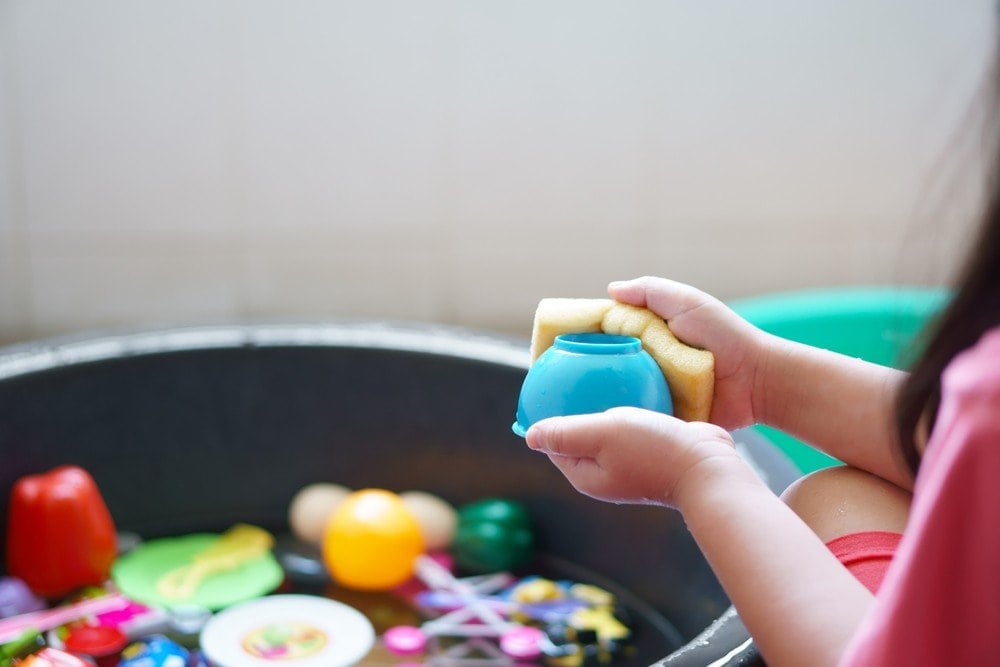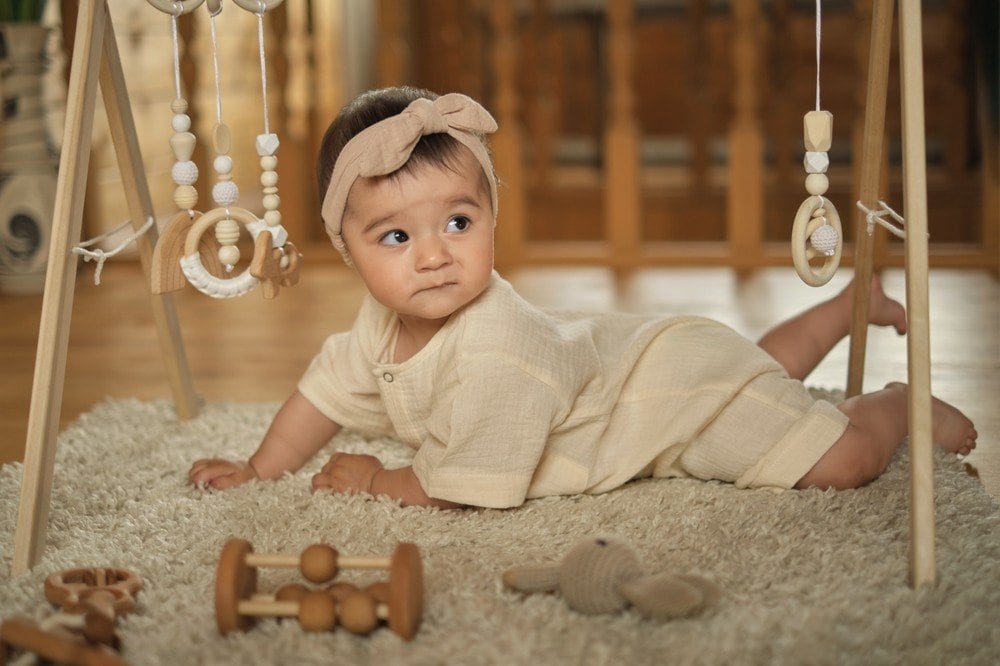As a parent, one of the most essential tasks you face daily is keeping your baby safe, happy, and healthy. Whether they’re teething or simply exploring the world with their hands and mouths, baby toys play a big role in their development. But when those toys end up in their mouths, you’re right to be concerned about germs, bacteria, and even potential harmful chemicals.
In this guide, we’ll explore how to disinfect baby toys that go in mouth using effective and safe methods. From plastic toys to stuffed animals, to those quirky rubber duckies that always seem to be a hit, keeping them clean is not just about hygiene—it’s about ensuring your baby’s safety and well-being.
Why Baby Toys Need to Be Disinfected
Every parent has experienced that heart-stopping moment when their baby pops a toy into their mouth, and you wonder, “How clean is this thing?” After all, babies put everything in their mouths! This is a normal part of their developmental stage as they explore the world around them, but it also means that these toys can quickly become breeding grounds for germs and bacteria.
Baby toys can accumulate dirt, saliva, sweat, and even airborne germs. Moreover, toys that are constantly in contact with your baby’s mouth can be a carrier for illnesses if not cleaned properly. Some toys, especially those that can’t be machine-washed, such as wooden toys or stuffed animals, present unique cleaning challenges. And we all know that baby hands can be everywhere—on the floor, in the mouth, and then back on the toys. It’s easy for toys to become contaminated with bacteria from surfaces and hands, making proper disinfection even more crucial.
How Often Should Baby Toys Be Cleaned?
Before we dive into how to disinfect baby toys, let’s talk about the frequency. How often should you disinfect toys that go in your baby’s mouth?
- Teething toys: These should be cleaned after every use, as babies tend to chew on them often.
- Bath toys: Clean after each bath session to prevent mold and mildew buildup.
- Plastic toys: Wipe down every day, especially if your baby is fond of chewing or sucking on them.
- Stuffed animals: Clean these at least once a week or more, depending on use.
When in doubt, always err on the side of cleaning more frequently. This helps eliminate any risk of germs spreading, ensuring a safer environment for your baby.
Best Ways to Disinfect Baby Toys That Go in Mouth

Now, let’s get into the heart of the matter: How do you disinfect baby toys that go in mouth? There are many methods available, and not all are suitable for every type of toy. We’ll explore various options, starting with some general cleaning methods that work across the board.
1. Soap and Water
For most toys, a simple solution of soapy water can do wonders. Whether the toy is made of plastic, rubber, or other non-electrical materials, you can immerse it in a mixture of warm water and mild dish soap.
- Plastic toys: These are generally safe to wash in the sink or even in the dishwasher (if they’re dishwasher safe).
- Rubber toys: Clean with a damp cloth and mild soap.
- Wooden toys: Avoid soaking these. Instead, use a soft cloth dampened with soapy water to wipe down the surface, then follow up with a dry towel to prevent water damage.
For stuffed animals, a gentle wash cycle or spot cleaning with a damp cloth is usually best. Don’t forget to check the care label for specific instructions.
2. Use of Vinegar and Water Solution
One of the most natural ways to disinfect baby toys is by using a vinegar and water solution. Vinegar is a non-toxic disinfectant that is safe for babies, and it works well to remove odors and germs. To make the solution:
- Mix 1 cup of white vinegar with 1 cup of water.
- Use a soft cloth or a spray bottle to apply the solution to the toys.
- After wiping down the toys, use clean water to rinse them thoroughly.
This solution is safe for almost all toys, except for those that might be damaged by moisture (like battery-operated toys). Also, vinegar is a great option for cleaning bath toys, as it helps to eliminate mold and mildew, which can grow in moist environments.
3. Hydrogen Peroxide
For toys that need a more thorough cleaning, hydrogen peroxide can be a useful option. It’s an excellent disinfectant and safe for most surfaces. Here’s how to use it:
- Mix 1 part hydrogen peroxide with 2 parts water.
- Spray or wipe it onto the toys, then allow it to sit for a few minutes to sanitize.
- Rinse thoroughly with water to remove any leftover residue.
It’s important to ensure that the toys are completely dry after cleaning, especially if they contain electrical components or batteries.
4. Disinfecting Wipes or Sprays
If you’re looking for a quick and efficient solution, disinfecting wipes or sprays designed for baby products can be a lifesaver. Look for products that are labeled baby-safe, such as those free from harsh chemicals or fragrances.
- Disinfecting wipes: Perfect for wiping down plastic toys, wooden toys, and teething rings.
- Disinfectant sprays: Spray directly on the toys, let them sit for a while, and then wipe away excess moisture with a dry cloth.
If you’re using commercial disinfectants, always check for safety labels to ensure they’re suitable for baby toys.
5. Boiling Water Method
For those toys that can handle a little more heat (mainly plastic and rubber toys), boiling water can be an excellent way to sanitize them.
- Bring a pot of water to a boil.
- Drop the toy in the water for about 2-3 minutes.
- Remove the toy using tongs and let it cool completely.
This method is particularly effective for toys like rubber duckies, which can be difficult to clean with soap and water alone.
Disinfecting Special Baby Toys
Some baby toys are more delicate and require special care when cleaning. Let’s take a look at a few of these:
1. Stuffed Animals
Stuffed animals, though beloved, can be tricky to clean, especially since many can’t be machine-washed. Here’s a simple approach:
- Spot clean: Use a soft cloth dampened with soapy water to gently clean the surface of the stuffed animal. Avoid soaking it, as this could damage the material or leave it soggy.
- Machine wash: If the toy is machine washable, place it in a laundry bag on a gentle cycle, and dry it thoroughly afterward.
For toys that can’t be washed, you can use a disinfecting wipe or sprinkle some baking soda on them to freshen them up before brushing it off.
2. Wooden Toys
Wooden baby toys are more delicate and need extra care. These should not be soaked in water, as it can cause the wood to warp or crack. Instead, use a damp cloth with a mix of mild soap and warm water to wipe them down.
After cleaning, immediately dry the toy with a dry cloth to prevent moisture from lingering.
Precautions to Take When Disinfecting Baby Toys

While cleaning and disinfecting are important, there are some precautions to keep in mind to ensure you’re not causing harm to your baby or their toys:
- Avoid harsh chemicals: Chemicals like chlorine bleach and ammonia can be too strong for baby toys. Always opt for gentle, non-toxic alternatives such as vinegar, hydrogen peroxide, or baby-safe disinfecting products.
- Dry thoroughly: Always make sure toys are completely dry before giving them back to your baby. Leftover moisture can promote bacterial growth, especially in stuffed toys and bath toys.
- Check care labels: Some toys have specific cleaning instructions. Always read the label before using water, soap, or any disinfectant.
FAQs on Disinfecting Baby Toys
1. How often should I disinfect baby toys?
Baby toys should be disinfected frequently, especially if they go into your baby’s mouth. Teething toys, bath toys, and toys that your baby uses daily should be disinfected at least once a day.
2. Can I use Lysol wipes to disinfect baby toys?
Yes, you can use Lysol wipes to disinfect baby toys, but make sure they are free from harsh chemicals and fragrances. Always choose a baby-safe wipe.
3. What is the best disinfectant for baby toys?
The best disinfectants are those that are natural and safe for babies. Vinegar solution, hydrogen peroxide, and baby-safe disinfecting wipes are excellent choices.
4. How do you disinfect stuffed animals?
Stuffed animals can be spot cleaned or machine washed (if washable). For delicate items, use a soft cloth and a mix of soap and water to gently clean.
5. How do you disinfect toys with electrical components?
Disinfect toys with electrical components carefully. Wipe down the surface with a damp cloth and mild soap, avoiding getting water into the electrical parts. Use a disinfecting wipe for quick clean-ups.
6. Can I disinfect baby toys with vinegar and water?
Yes, a vinegar and water solution is a safe and effective way to disinfect baby toys. It’s non-toxic and great for cleaning both hard and soft toys.
7. How do you clean bath toys without mold?
To prevent mold, regularly clean bath toys using vinegar solution and let them air dry thoroughly. Ensure there’s no water trapped inside.
Conclusion
Disinfecting baby toys that go in the mouth is more than just a matter of cleaning—it’s about keeping your baby safe from harmful germs, bacteria, and potential toxins. By following these simple yet effective methods, you can ensure that your baby’s toys are clean, sanitized, and safe for them to chew, play, and explore.
From natural solutions like vinegar and water to quick fixes with disinfecting wipes, there’s no shortage of ways to keep your baby’s toys germ-free. Always remember to choose non-toxic, gentle cleaning products to protect your baby’s delicate health. With just a little bit of extra effort, you can rest assured that your baby is playing with toys that are both fun and safe.